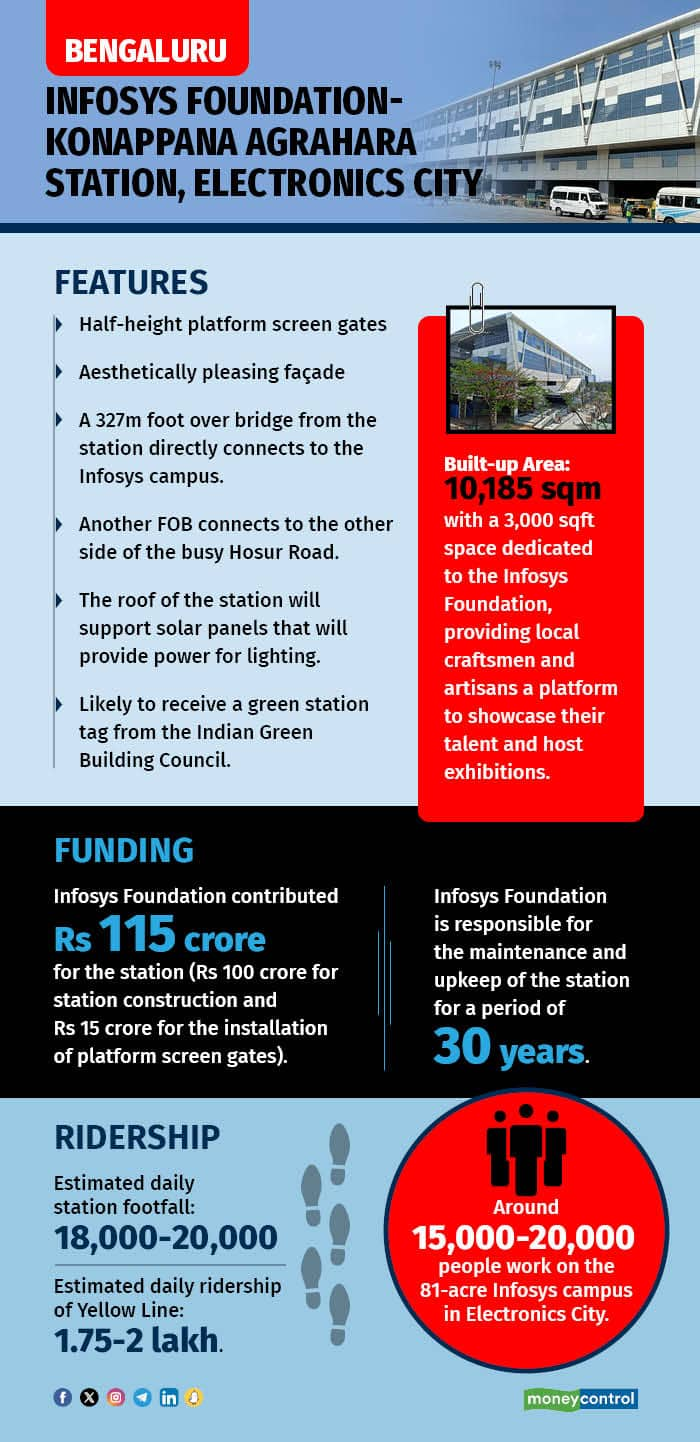



Bengaluru Metro users are likely to have a new experience once the Infosys Foundation-funded Konappana Agrahara Station in the tech hub of Electronics City becomes operational by the end of the year.
Bangalore Metro Rail Corporation Ltd (BMRCL) officials said the station will have facilities such as half-height platform screen gates, an aesthetically pleasing façade, direct station access to the Infosys campus, and space for exhibitions. The station is also likely to receive a green certification from the Indian Green Building Council.
Officials said Electronics City Metro (Yellow Line connecting RV Road to Bommasandra) will be operational by December 2024, subject to the arrival of train sets.
Also, read: Titagarh to supply the first train for Bengaluru metro’s Electronics City corridor in August 2024
BMRCL Chief public relations officer BL Yashavanth Chavan told Moneycontrol that Infosys Foundation contributed Rs 115 crore for the station (Rs 100 crore for station construction and Rs 15 crore for installation of platform screen gates).
Chavan said the estimated daily footfall at the station will be 18,000-20,000. "The daily ridership of the entire Yellow Line is likely to be 1.75-2 lakh." he said.
Some 15,000-20,000 techies work on Infosys' 81-acre green campus in Electronics City.Infosys Foundation will be responsible for the maintenance and upkeep of the station for a period of 30 years.

This will also be the first metro station in Bengaluru to get half-height platform screen gates. BMRCL is also planning full-height platform screen doors (PSDs) at two existing underground stations (Purple Line): Nadaprabhu Kempegowda station at Majestic, and Sir M Visvesvaraya station, Central College.
In Phase 2, full-height PSDs will be installed at all underground stations on Reach 6 (Kalena Agrahara (Gottigere) - Nagawara) on the Pink Line corridor) and the partially underground Airport Line terminal station. Half-height PSGs will be installed at one at-grade station (Airport City station on the Blue Line).
Experts say that these protective barriers between the platform and the tracks enhance commuter safety. Synchronised with metro coach doors, PSDs only open after the train comes to a complete halt. Metro corporations in Delhi and Chennai have already implemented PSDs, particularly at underground stations.
Direct connectivity to Infosys campusKonappana Agrahara Station will have two foot overbridges. One will allow passengers to cross the busy Hosur Road it is situated on, and the other will be a 372-metre link to the Infosys campus.
The station was designed by New Delhi-based SYSTRA, and Sobha Developers executed the architectural finishing work. The station also has facilities like lifts, escalators, walkways, bus shelters, public information systems, washrooms, drinking water, etc.
Also, read: Delta Electronics gets Bengaluru Metro station naming rights; signs MoU
While Konappana Agrahara Station does not have parking facilities, Bengaluru Metropolitan Transport Corporation (BMTC) will operate feeder bus services to and from the station for first and last mile connectivity. The station will also have bus bays and pick-up points for auto rickshaws and cabs.
Space for exhibitionsThe station has a total built-up area of 10,185 sq m. Officials said that 3,000 square feet have been allocated to the Infosys Foundation, providing local craftsmen and artisans with a platform to showcase their talent and host exhibitions.
Lighting at the station will be solar-powered. Chavan said, "The roof of the station is designed to support solar panels, and the installation is in progress and is expected to be operational when the line is operational for the public."
Chavan said rock wool insulation for exterior walls has been used to prevent heat transfer, while Kalzip energy-saving roof systems have been used to reduce the energy consumption. He said they have also approached the Indian Green Building Council for green certification of the station.
Also, read: From funding stations to painting pillars, here’s how corporates are boarding the Bengaluru Metro
Naresh Venkataraman, a senior architect, said: "Most Bengaluru Metro stations look like they’re just designed to move people from the pavement to the train and back," he said.
He said station buildings can be reimagined as community hubs, incorporating spaces for senior citizens, children and Residents Welfare Associations (RWAs).
Venkataraman suggested utilising the empty floors in many station buildings for community activities such as kindergartens, co-working spaces, sports centes and primary health centres.
"A good design is not necessarily expensive but a bad design definitely is. BMRCL should have better community involvement in station planning. Stations could become valuable assets for the community if designed thoughtfully," he added, noting the importance of inviting public suggestions to transform these spaces into civic and social infrastructure, especially given the city's space constraints.
Also, read: MC Explains: Overcrowded Bengaluru Metro coaches: Fallout of Indo-China conflict

Discover the latest Business News, Sensex, and Nifty updates. Obtain Personal Finance insights, tax queries, and expert opinions on Moneycontrol or download the Moneycontrol App to stay updated!
Find the best of Al News in one place, specially curated for you every weekend.
Stay on top of the latest tech trends and biggest startup news.